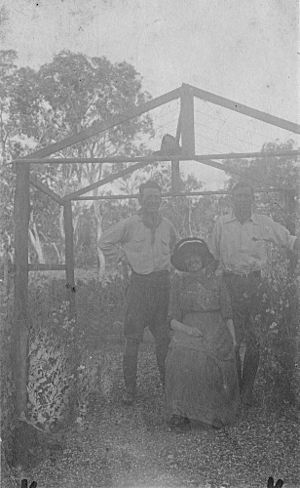Jean White-Haney facts for kids
Rose Ethel Janet White-Haney (born March 11, 1877 – died October 21, 1953), known as Jean White-Haney, was an important botanist in Queensland, Australia. A botanist is a scientist who studies plants. She led the Queensland Board of Advice on Prickly Pear Destruction. She helped find ways to control this harmful cactus using natural methods.
Contents
Early Life and Learning
Jean White was one of eight children. Her father, Edward John White, was an astronomer. She studied at home until she was 15. Then she went to Presbyterian Ladies' College in Melbourne. Later, she attended the University of Melbourne. She earned her Bachelor of Science (B.Sc.) in 1904. She then got her Master of Science (M.Sc.) in 1906. In 1909, she earned her Doctor of Science (D.Sc.). She was only the second woman in Australia to get a Doctorate of Science.
Jean received a special scholarship for her research. She worked in the Botany Department. Between 1907 and 1911, she published many scientific papers.
Fighting the Prickly Pear Cactus
In 1912, Jean was put in charge of an experimental station. This station was in Dulacca. Its goal was to fight the prickly pear cactus. This cactus was a big problem in Queensland. It was taking over farmland. Jean worked there until 1916. She looked for insects and chemicals to control the cactus.
On February 22, 1915, she married Victor William Haney. He was a chemist who studied farming.
Dr. White-Haney had a big success. She used tiny cochineal insects (Coccus indicus) to fight one type of tree cactus. This cactus was common in North Queensland. Even though these insects did not work on all prickly pear types, her success was very important. It showed that using insects (biological control) could work. This encouraged scientists to keep looking for solutions. This search later led to the Cactoblastis cactorum moth. This moth finally helped control the prickly pear pest. Jean wrote three reports about her work at the station. The station closed in 1916. It became hard to get staff and chemicals during World War I.
Later Life and Discoveries
After her work at Dulacca, Jean took a break. She focused on raising her two sons. During this time, she lived in Brisbane. She helped start the Lyceum Club. She also joined the committee of the Queensland Bush Book Club.
In 1926, she went to a big science meeting in Tokyo. Later, she worked for the Council for Scientific and Industrial Research. This job took her all over Australia. Her last scientific work was studying weeds. These weeds were called Noogoora and Bathurst burr. In 1930, she moved to the United States. Jean White-Haney passed away in Camarillo, California, on October 21, 1953. She was buried in Inglewood Park Cemetery.
See also
 In Spanish: Jean White-Haney para niños
In Spanish: Jean White-Haney para niños


